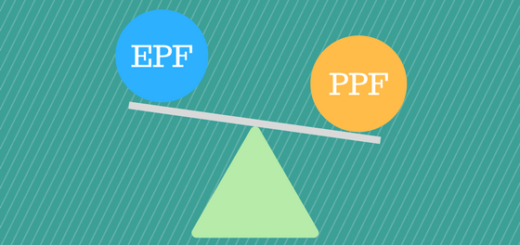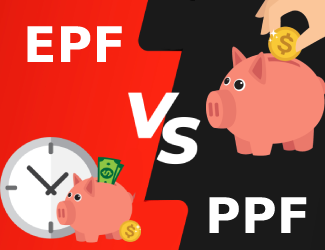Table of Contents
ToggleEPF Vs PPF: Which is the Best Option?
Employees’ Provident Fund (EPF) and public provident fund (PPF) considered the two most recommended saving schemes in India. Since both are government-backed and retirement projects, there is a lot of confusion among investors regarding these investment schemes. Therefore, if you are planning to invest in EPF or PPF then it becomes compulsory to understand the difference between these two.
We have covered the following in this article:
What is EPF?
Employee Provident Fund is a retirement savings scheme that is associated with the employees of the organized sector. These funds deducted from your salary as PF goes to your PF account, which is maintained by the Employee Provident Fund Organization for post-retirement life.

What is PPF?
PPF or public provident fund is a scheme started by the government of India which is open to everyone i.e. employed, unemployed, or even retired. One can easily invest any amount to PPF subject to a minimum of Rs 500 to a maximum of Rs 1.5 lakh per year. PPF account can be open by any post office or by any major banks.
Difference Between EPF and PPF
Parameter | PPF | EPF |
Eligibility to Invest | All individuals, including those who are associated with the informal sectors | Any employee salaries under the recognized organization.. |
Investment Amount | Between Rs 500 to 1,50,000 | Compulsorily 12 % of salary, DA. It can be increased voluntarily |
Tenure | 15 Years, extendable after that for a block of 5 years indefinitely | Can be closed while quitting job permanently. Can be transferred while changing companies till retirement. |
Current Rate of Interest | 7.1% | 8.50% |
Contributor to Fund | Self (Parent in case of a minor) | Both Employer and Employee |
Tax Benefit | The contribution is tax-deductible under Sec 80C. While the maturity amount is also tax-free. | The contribution is tax-deductible while Maturity amount is tax-free only on completion of 5 years. |
How to Calculate Interest on EPF?
EPF calculator: EPF calculator is a tool used to calculate the interest on EPF. EPF is calculated every month but is credited in the account at the end of the financial year.
Let’s understand the calculation of interest for a financial year by the following example:-
Basic Salary + Dearness Allowance = ₹ 12,000
- Employee’s contribution towards EPF = 12% of ₹ 12,000 = ₹ 1,440
- Employer’s contribution towards EPS = 8.33% of ₹ 15,000 = ₹ 1,000
Employer’s contribution towards EPF = Employee’s contribution – Employer’s contribution towards EPS = ₹ 440
Total EPF contribution every month = ₹ 1,440 + ₹ 440 = ₹ 1,880
How to Calculate Interest on PPF?
PPF Calculator: PPF calculator is a tool used to calculate interest on PPF. It is calculated on the basis of compound interest calculation formula and the compounding of the PPF principal occurs annually i.e. once a year.
The formula for the PPF calculation is as follows:
A = P (1+r) ^t
Where, A= PPF Maturity Amount.
P=PPF Principal Amount invested.
R= PPF rate of interest.
T=Time period
The above formula stated that the longer you will stay invested with PPF, greater is the amount of interest you can earn on your PPF account.
PPF Calculation for investment periods of:
- 15 years
- 20 years
- 30 years
Let’s understand the PPF calculation with the example, to know that PPF compounding work in your favor or not?
Suppose, we are calculating interest on PPF for 15, 20 and 30 year periods*:
Investment Period | Total Investment in PPF | Gross Interest Earned | Maturity Value |
15 years | Rs. 1.5 lakh | Rs. 1.4 lakh | Rs. 2.9 lakh |
20 years | Rs. 2 lakh | Rs. 2.88 lakh | Rs. 4.88 lakh |
30 years | Rs. 3 lakh | Rs. 9 lakh | Rs. 12 lakh |
In this PPF calculation example, we have supposed that the amount of annual investment is Rs. 10,000 and the current PPF interest rate is 7.1% per
The above example shows the result of compounding in PPF i.e. your maturity amount increases from Rs. 2.9 lakh to Rs. 12 lakh just by investing Rs. 1.5 lakh in 15 year period therefore this shows as long as you stay invested in your PPF account for 30 years instead of 15 years.
Withdrawal Eligibility of EPF and PPF
EPF Withdrawal:
- You can withdraw 75% of your EPF if you have been unemployed for a period of one month else, you can withdraw the entire EPF if your unemployment extends to two months. However, if you will withdraw your EPF within 5 years of EPF account opening, then the withdrawal amount will be taxable.
- If in case you will become unemployed or become self-employed or will start working in any unorganized sector. Therefore, in this case, the EPF balance will continue to earn interest but will be taxable. However, after three years it will not continue adding interest in the account.
- Where the retirement age of EPF is 58 years. After attaining this age, you can withdraw most of your amount and the remaining which is used for Employee’s pension scheme (EPS) will be paid to you as pension and will be taxable.
PPF Withdrawal:
- In this case, you can’t withdraw your PPF’s account money due to unemployment. You can only withdraw the whole amount of the same after a maturity period of 15 years otherwise you can make partial withdrawals after the expiry of 6 years and the start of the 5th year of account opening.
Note: Some banks, such as SBI and HDFC allow withdrawals after 7 years.
The maximum amount that can be withdrawn in a financial year is the following:
- Either 50% of the account balance as at the end of the financial year, prior to the current year, or
- 50% of the account balance as at the end of the 4th financial year, prior to the current year.
Bottom Line
Both PPF and EPF are beneficial to investors as they both are tax-saving and provides after retirement benefits. Also, both the scheme secures the post-retirement needs of the investor.
We’ve also observed that the investor can choose any of the benefits as per the requirement but can analyze the difference on the basis of the Rate of interest or the withdrawal criteria of both investments.
Frequently Asked Questions







































